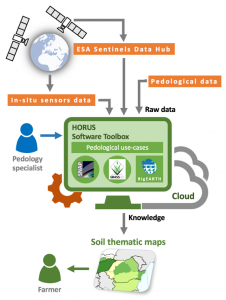
The main objective of the HORUS Toolbox project concerns with using of Earth Observation data, especially data provided by Sentinel-2, in a very practical and efficient manner, to carrying out pedology studies and producing pedology maps, in the particular context of Transylvanian area. Currently the main soil data sources in the area are represented by field studies, sample analysis and in-situ offline sensors, covering only a small region from the Transylvanian area that we are experimenting. Although oriented on Transylvanian area as the main area of interest, functionalities implemented in HORUS Toolbox will be easily adapted for pedological studies in other regions, mainly based on Copernicus products, but also enabling the integration of other data sources that might be available.
Another main objective is to develop software tools that support the flexible description and adaptive processing of big Earth Observation data. The goal is to enable the seamless integration of available Sentinel-2 product as a new reliable data source and facilitate information processing with already developed open-source processing technologies.
Sustainable development can be achieved only through coordinated efforts from all involved parties and individuals. Furthermore, continuous improvement of HORUS Toolbox should be always steered towards the necessities of the pedological and agricultural communities, objective that can be better achieved with the involvement of active participants from this community.
The HORUS project aims to start from the level TRL2 and TRL3 and to reach the TRL5 level. Each work package will increase the current level of maturity, at the end of project the technology readiness level will be TRL5, meaning the BETA version of the HORUS software product.
The HORUS project – Software Toolbox for Pedological Monitoring of Transylvanian Area based on Sentinel-2 Data has as main objectives:
- using Copernicus products in pedology studies for Transylvanian area
- development of tools for pedology studies based on Earth Observation data
- building a community for sustainable development
